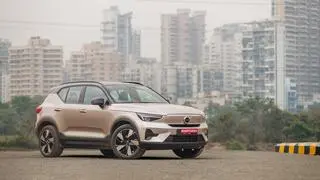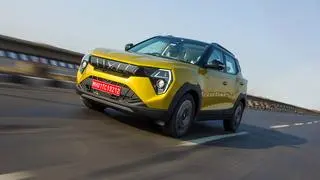Earlier this month I had just finished driving the MG ZS EV over more than 1,600 km to prove that it is possible to do long distance travel in an electric (a Mumbai to Chennai travelogue is due in this column in the coming weeks). So, when I landed at the Buddh International Circuit in Greater Noida near Delhi just a day later, to drive the MG Astor, it almost looked like a comprehensive facelift of the ZS EV.
Of course, I was aware that buzzing under the bonnet of the Astor, that was idling in the pit lane for me, was a turbo-charged petrol engine and not an electric motor. The Astor is the ICE version of the ZS EV, but as I drive it around the track and soak-in its interiors, I realise that it is much more than that.
Design
Yes, the Astor’s design is nearly identical to the ZS EV. In fact most of the body panels are identical. That makes the Astor’s crossover body style different from the more upright SUV body styles prevalent amongst competitors like the Hyundai Creta, Kia Seltos, VW Taigun and Skoda Kushaq. It still bears MG’s SUV DNA and is likely to strike a chord amongst its buyers. The most obvious change to the front of the Astor is the celestial bonnet grille and its 3D radiating design pattern with the MG logo sitting in the middle of the Hexagonal outer frame.
The LED headlamps, tail-lamps and the matching LED ‘Hawkeye’ DRL light signatures are new and give the Astor a distinct character. The 17-inch machined alloys and the dual chrome exhausts at the rear fender are a couple of new design elements too. Lots of badging identifying this as a MG and of course it also gets the large ASTOR branding on the tailgate. In addition, the ZS and ADAS badges at the rear identify its lineage and the fact that this is a ‘Autonomous Level 2’ automobile (more on that later). The Brit 220 dynamic badge on my test mule was referring to the trim variant. Remember Hector and its ‘internet inside’ badge? The Astor gets a ‘AI Inside’ badge instead - the abbreviation referring to Artificial Intelligence.
Cabin
The Astor’s cabin is familiar too, especially for me, after having just spent nearly 26 hours over three days inside the ZS EV. But the difference compared to the design similarity of the exterior, was that the cabin feels like a huge upgrade compared to the ZS electric. The layout and the deign of the individual elements is identical; but the quality and type of materials used is significantly better. Artificial leather clad dash panels, textured plastics and a dual-tone colour theme — my test mule sported a sangria red and dark grey theme, give the Astor’s cabin an air of premiumness.
The other colour theme options include an ivory and black, and all black with contrast stitching. Brushed aluminium accents, a flat-bottomed, multi-function steering wheel clad in perforated leatherette and a larger 25.7cm HD touchscreen (compared to the ZS EV), are some of the other features in the cabin.
The space available in the cabin and the boot are identical to the ZS EV, but the seats are a bit more comfy in the Astor. The rear bench seat’s backrest angle is just a shade better and there is more under thigh support. There is also the addition of a dedicated rear air-conditioning vent. The main aircon also gets a PM2.5 filter for improved air quality. The panoramic sunroof will be another feature that many buyers will like. Depending on the trim variant, the Astor will also get auto headlamps, rain-sensing wipers, electrical seat adjustments, 17.8cm digital instrument cluster and a number of connected car features.
The one feature in the Astor that will first strike anyone one stepping in is the cute animated AI assistant that sits on top of the centre stack. Occupying the spot where most other cars offer a perch for a deity, the animated, toy-like assistant is just a motorised tiny screen that listens, emotes and responds to voice commands. Seems gimmicky to me, but I guess a lot of buyers will find it novel and usable. Based on voice commands, it can connect to the web using an embedded SIM to deliver news, info from Wikipedia, perform connected car functions and even crack jokes.
Performance
The new Astor will be offered with two petrol engines and three gearbox options between them. There is no Diesel engine, even though there are competitors that still offer them. The only powertrain that was offered for test drives at the BIC was the 1.3-litre turbocharged petrol with the torque converter automatic. Bearing a ‘220Turbo’ nomenclature in my test mule variant, which was also badged ‘Brit Dynamic 220, the 1,349cc engine generates 140PS of peak power and 220Nm of peak torque.
The 3-cylinder engine is a bit raucous under hard acceleration and that was something that I experienced more possibly because I was at the F1 track. Acceleration level was expectedly average with the gearbox also tuned for relatively relaxed shifts. Turbo-lag is evident, though once the needle passes the 2,500rpm level the Astor finally delivers a quicker pace.
The suspension set up in the Astor feels better than in the ZS EV, with more control over body roll and in general a firmer ride. It is still a touch too pliant, though my guess is that the average Indian owner at the rear seat will appreciate the ride quality. Braking performance is good with disc brakes all around; red calipers make them look good too. The electronic power steering has three modes to choose from - normal, urban and dynamic. The system also automatically chooses the setting based on speed.
The other option is a 1.5-litre petrol engine that generates 110PS of power and 144Nm of torque. There is the option of choosing either a 5-speed manual or a CVT (continuously variable transmission) gearbox.
Bottom line
The Astor is also a Autonomous Level 2 vehicle and is offered with a long list of ADAS functions (advanced driver assistance systems). Using five cameras and two radar systems onboard, the functionality is broadly under categories like lane assistance, rear drive assist, adaptive cruise control and emergency braking, speed assistance and intelligent headlamp control.
I could try out a few of the functions at the BIC and the Astor performed as expected. Rear cross traffic assist, lane keeping and emergency braking will certainly be useful in the Indian driving cycle. There are a total of 49 safety features including six airbags in the top variant; of the total 27 safety features are part of standard fitment across variants.
In fact, MG has done what it does best by loading up the Astor with features, more tech and more value than is offered by the competitors in the segment. The Astor is being offered with four variants - Style, Super, Smart and Sharp. Even the base variant is quite loaded and has been priced at ₹9.78 lakh. MG has also announced very competitive service packages for the Astor. The top trim Sharp 220 Turbo AT is priced at ₹16.78 lakh. Overall, these are very competitive prices for a loaded compact SUV.







Comments
Comments have to be in English, and in full sentences. They cannot be abusive or personal. Please abide by our community guidelines for posting your comments.
We have migrated to a new commenting platform. If you are already a registered user of TheHindu Businessline and logged in, you may continue to engage with our articles. If you do not have an account please register and login to post comments. Users can access their older comments by logging into their accounts on Vuukle.